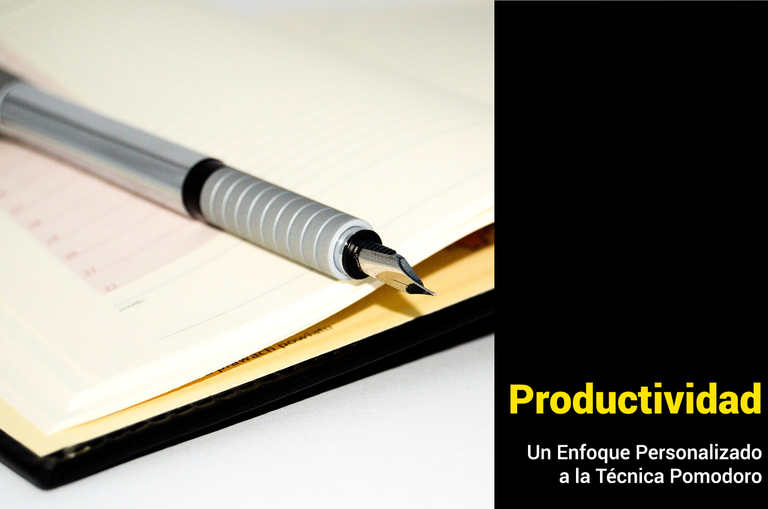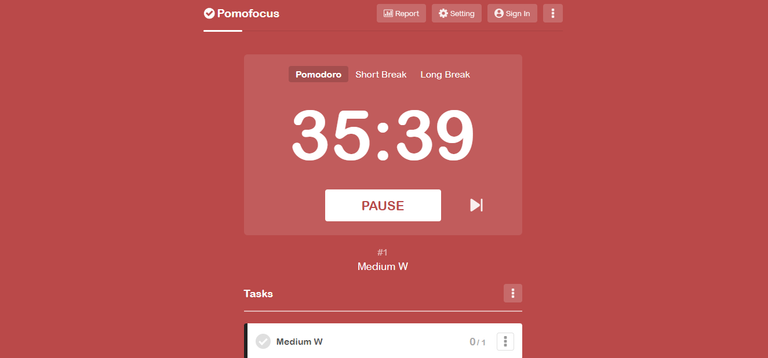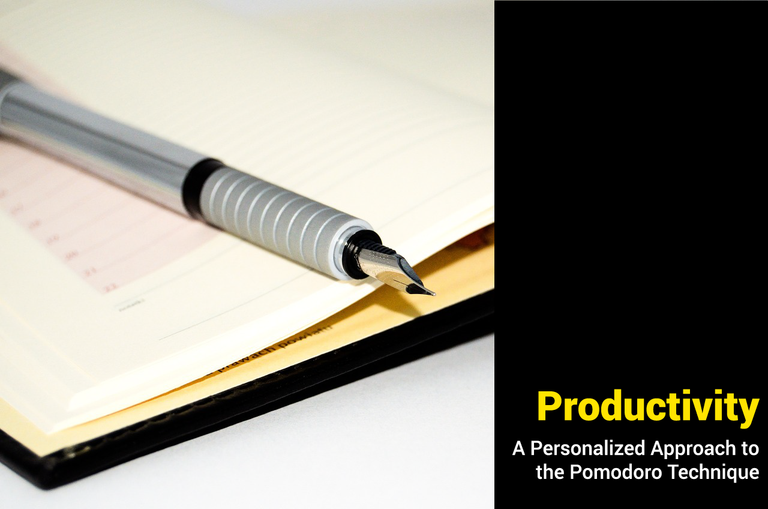This article has an English version which you can access here
[ESP] Productividad: Un Enfoque Personalizado a la Técnica Pomodoro

La productividad siempre ha sido un desafío para mí. Parece que nací bajo la sombra persistente de una nube de procrastinación, posponiendo constantemente lo urgente. ¿Acaso hay un mejor momento para lavar los platos que cuando tienes una pila de papeles pendientes?
Con el tiempo, y después de innumerables intentos fallidos de crear rutinas poco creíbles y pasar horas procrastinando viendo videos sobre cómo dejar de procrastinar en YouTube, he ido descubriendo poco a poco lo que mejor se adapta a mi personalidad y a mis condiciones de vida. Por eso, hoy quiero compartir contigo algunos consejos y técnicas que me han ayudado, y otros que no funcionaron conmigo, pero que podrían funcionar contigo. Así que, sin más preámbulos, comencemos.
La Técnica Pomodoro + La regla de los 5 minutos
La Técnica Pomodoro
A estas alturas, creo que todos hemos escuchado hablar en alguna ocasión de la famosa técnica del Pomodoro, ese utensilio de cocina devenido en herramienta para el estudio. Con aumentos de productividad y rendimientos demostrados, según un estudio realizado en la Universidad de Lancaster que investigó la efectividad de la Técnica Pomodoro para ayudar a los estudiantes a manejar mejor la multitarea basada en tecnología durante el estudio independiente, esta técnica ha sido altamente difundida pero no muchos logran adoptarla.
Referencia:
Usman, S. A. (2020). Using the Pomodoro Technique® to help undergraduate students better manage technology-based multitasking during independent study: A design-based research investigation. Tesis doctoral, Department of Educational Research, Lancaster University, UK. Recuperado de https://eprints.lancs.ac.uk/id/eprint/153513/1/2020usmanphd.pdf
Llegué a esta técnica con mis recelos, y durante las primeras sesiones no lograba que me funcionara. Interrupciones constantes, se me olvidaban los tiempos, o llegaba el tiempo de descanso en el momento de máxima energía de trabajo y tenía que volver a encontrar esas energías.
La regla de los 5 minutos
El problema era que estaba siguiendo las reglas ya escritas en lugar de crear las mías propias. La Técnica Pomodoro implica trabajar intensamente durante 25 minutos (lo que representa un “Pomodoro”), seguido de un descanso de 5 minutos, y después de cada cuatro “Pomodoros”, tomar un descanso más largo de 15 a 30 minutos. Aquí es donde entra en juego la regla de los cinco minutos: si una tarea te lleva menos de cinco minutos, entonces hazla. A partir de este momento, todas mis tareas quedaron de la siguiente forma:
- 5 minutos: Elección de la tarea, organización del puesto de trabajo, ten cerca de ti todo lo que necesites.
- 40 minutos: Definitivamente, mi mayor problema eran estos 25 minutos. Se me hacían demasiado cortos y, cuando más enganchado estaba a la tarea, terminaban. Así que lo aumenté a 40 minutos, obteniendo mejores resultados.
- 10 minutos: Dedicados a tareas menores dentro de mi tarea principal. Por ejemplo, si estoy revisando las evaluaciones de mis estudiantes y necesito llevar un registro de sus dificultades, utilizo estos 10 minutos para realizar estos registros.
- 15 minutos: ¡Ahora sí! Los 5 minutos no me alcanzaban por lo general para descansar, así que los aumenté a 15. En la mayoría de los casos, uso estos 15 minutos para hacer mi lección de Duolingo o leer algo en Quora.
- Repetir desde el punto 2.
Por lo general, mis tareas no llevan más de dos repeticiones, por lo tanto, estos son unos ajustes muy personales. Debes encontrar los tuyos propios.
Si estás buscando aplicaciones para Pomodoro, encontrarás muchísimas con muchos añadidos y funciones. En lo personal, prefiero Pomodoro Timer o la web pomofocus.io, que tienen una interfaz muy cuidada e intuitiva.

Lo más importante a la hora de poner en práctica estos métodos es tener un lugar tranquilo y destinado a este momento, evitando las distracciones externas, las redes sociales y las notificaciones telefónicas. También juega un papel importante trabajar solo en una tarea a la vez en lugar de la multitarea, aunque el estudio citado demuestra que si puede ayudar para la multitarea, en mi caso, saltar de un pendiente a otro solo lograba distraerme.
Así, combinando estas dos técnicas y después de varios intentos fallidos, logré ajustarla a mi vida, sin presiones y hasta donde lo estime conveniente. Hubo momentos de frustración y desánimo, pensando que debería regresar al método hazlo cuando puedas.
Palabras finales
Para mejorar la productividad hay investigaciones, sí, pero no hay una verdad absoluta. Adapta y mejora, cambia lo que no te funcione, aprópiate y mezcla métodos y herramientas. Investiga y conócete, cuáles son tus momentos del día más productivos, qué te hace procrastinar y busca la forma más efectiva de combatirlo.
Cada uno de nosotros es único, y lo que funciona para uno puede no funcionar para otro. Así que te animo a que pruebes, a que experimentes y a que encuentres ese método que se adapte a ti, a tu ritmo y a tus necesidades. Recuerda, la productividad no se trata de hacer más, sino de hacer lo que importa. Y estoy seguro de que tú, al igual que yo, puedes encontrar esa fórmula que te permita vivir una vida más productiva y satisfactoria.
Por último, quiero aconsejarte algo muy importante: descansa. No serás productivo con sueño o agotado. Tómate tu tiempo para recobrar energías, dar un paseo o tener un poco de compañía, virtual o real.
Quiero agradecerles sinceramente por tomarse el tiempo de leer este artículo. Su apoyo significa mucho para mí y me motiva a seguir compartiendo contenido que pueda ser útil e interesante para ustedes. Si encontraron este artículo útil o disfrutaron leyéndolo, les agradecería enormemente que lo compartieran con sus amigos o en sus redes sociales. Éxitos.
Recursos utilizados:

[ENG] Productivity: A Personalized Approach to the Pomodoro Technique

Productivity has always been a challenge for me. It seems that I was born under the persistent shadow of a cloud of procrastination, constantly postponing the urgent. Is there a better time to wash the dishes than when you have a pile of pending papers?
Over time, and after countless failed attempts to create unbelievable routines and spending hours procrastinating watching videos on how to stop procrastinating on YouTube, I have gradually discovered what best suits my personality and my living conditions. That’s why today I want to share with you some tips and techniques that have helped me, and others that didn’t work for me, but could work for you. So, without further ado, let’s get started.
The Pomodoro Technique + The 5-minute rule
The Pomodoro Technique
By now, I think we’ve all heard at some point about the famous Pomodoro technique, that kitchen utensil turned study tool. With demonstrated productivity increases and yields, according to a study conducted at Lancaster University that investigated the effectiveness of the Pomodoro Technique in helping students better manage technology-based multitasking during independent study, this technique has been widely disseminated but not many manage to adopt it.
Reference: Usman, S. A. (2020). Using the Pomodoro Technique® to help undergraduate students better manage technology-based multitasking during independent study: A design-based research investigation. Doctoral thesis, Department of Educational Research, Lancaster University, UK. Retrieved from https://eprints.lancs.ac.uk/id/eprint/153513/1/2020usmanphd.pdf
I came to this technique with my suspicions, and during the first sessions I couldn’t get it to work for me. Constant interruptions, I forgot the times, or the rest time came at the moment of maximum work energy and I had to find those energies again.
The 5-minute rule
The problem was that I was following the already written rules instead of creating my own. The Pomodoro Technique involves working intensely for 25 minutes (which represents a “Pomodoro”), followed by a 5-minute break, and after every four “Pomodoros”, take a longer break of 15 to 30 minutes. This is where the five-minute rule comes into play: if a task takes you less than five minutes, then do it. From this moment on, all my tasks were as follows:
- 5 minutes: Choice of task, organization of the workplace, have everything you need close to you.
- 40 minutes: Definitely, my biggest problem was these 25 minutes. They were too short for me and, when I was most hooked on the task, they ended. So I increased it to 40 minutes, getting better results.
- 10 minutes: Dedicated to minor tasks within my main task. For example, if I am reviewing my students’ evaluations and need to keep a record of their difficulties, I use these 10 minutes to make these records.
- 15 minutes: Now yes! The 5 minutes were not enough for me to rest, so I increased them to 15. In most cases, I use these 15 minutes to do my Duolingo lesson or read something on Quora.
- Repeat from point 2.
In general, my tasks do not take more than two repetitions, therefore, these are very personal adjustments. You must find your own.
If you are looking for Pomodoro applications, you will find many with many add-ons and functions. Personally, I prefer Pomodoro Timer or the web pomofocus.io, which have a very careful and intuitive interface.

The most important thing when implementing these methods is to have a quiet place dedicated to this moment, avoiding external distractions, social media, and phone notifications. It also plays an important role to work on only one task at a time instead of multitasking, although the cited study shows that it can help with multitasking. In my case, jumping from one task to another only managed to distract me.
Thus, combining these two techniques and after several failed attempts, I managed to adjust it to my life, without pressures and as far as I deem convenient. There were moments of frustration and discouragement, thinking that I should return to the do it when you can method.
Final words
To improve productivity there are investigations, yes, but there is no absolute truth. Adapt and improve, change what doesn’t work for you, appropriate and mix methods and tools. Investigate and know yourself, what are your most productive moments of the day, what makes you procrastinate and look for the most effective way to combat it.
Each of us is unique, and what works for one may not work for another. So I encourage you to try, to experiment and to find that method that suits you, your pace and your needs. Remember, productivity is not about doing more, but about doing what matters. And I am sure that you, like me, can find that formula that allows you to live a more productive and satisfying life.
Finally, I want to advise you something very important: rest. You will not be productive with sleep or exhausted. Take your time to regain energy, take a walk or have some company, virtual or real.
I sincerely want to thank you for taking the time to read this article. Your support means a lot to me and motivates me to continue sharing content that may be useful and interesting to you. If you found this article useful or enjoyed reading it, I would greatly appreciate it if you could share it with your friends or on your social media. Successes.
Resources used:
